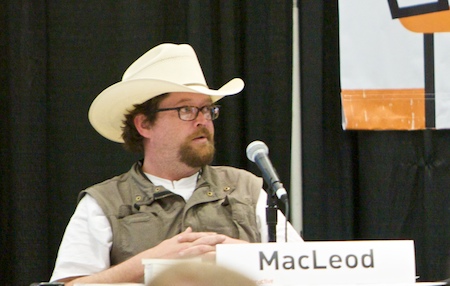The Broadcast Anomaly

South by South West Interteractive was even more of a whirlwind than I imagined it would be, and I had imagined it being frenetic. The event brings together people from the film, music and digital interactive spaces, which provides a rich context in which to talk about the future of marketing.
In between the Digital Mission events I caught a few panels, and (in true SXSW style) had lots of corridor conversations with industry verterans. For me, one of the highlights was meeting with Hugh MacLeod, aka GapingVoid. Hugh was one of the first bloggers I started to read, and I’ve been a long-time admirer of his cartoons (a warning: some strong language). I think it would be fair to describe him as an accidental artist – in fact I’m sure those are his words not mine. I have come up through an engineering and technology route to the marketing world, or as Hugh put it, I’m a “geek.” Hugh started in the marketing agency domain, before arriving into the technology world via blogging, back at the beginning of the century. That gives him a unique perspective on both the old and new marketing worlds.
As we sat in a favourite SXSWi watering hole, the Ginger Man, I quizzed him about where he saw marketing going and listened to his stories. I also sat in on the blog to book panel towards the end of SXSWi, but more of that later – and on Hugh’s upcoming book Ignore Everybody: and 39 Other Keys to Creativity (sample excerpts and pre-review)
Over the last year I’ve come to the conclusion that it is best to interpret broadcast media, and the broadcast marketing that comes with it, as an anomoly. Since the invention of radio and TV advertising, marketers have been able to “buy” our attention by inserting adverts into content that we choose to consume. I distinguish radio and TV from earlier billboard and poster advertising, since they are media that already have our attention before the advert. With poster ads, marketers had to win our attention; with broadcast ads marketers simply need to make sure that they don’t loose our attention.
Arguably, broadcast media has laid waste to innovative marketing and made marketers lazy. Big brands have lived off of the program-ad-program sandwich “bait and switch” format for a generation, but we aren’t playing the attention game anymore. About the time that our second child was born we got a large screen TV. Not for us – the TV is hardly ever on when we are home – but for our baby sitters. Having a big screen TV made us an attractive employer for sitters.
Times have changed. Just before I headed over to the US for SXSW, our baby sitters arrived. They didn’t ask for the TV remote, they asked for the WiFi password so they could surf the web on their laptops. The younger generation is increasingly switching from watching TV to surfing the Internet. The older generations are too. The story is just by way of example, the broader trend is supported by industry statistics too.
Along with the switch from the big screen to the “small screen” we’ve become increasingly immune to advertising. Experiments that monitor eye-scanning patterns of web surfers show that they quickly learn where ads are placed in the page, and avoid looking at them. Our attention can no longer be so easily bought. The web doesn’t support bait and switch. If people (and the brands that employ them) want to get our attention, then they are going to have to be much smarter than they have been in the past. They either have to get better and better at grabbing attention, or to switch from interuption-based marketing, to conversational marketing.
In parallel, the growing domination of web search as the means of information gathering has changed the way that people look for products. Marketing is increasingly about discovery, rather than broadcast. A transition from from push (broadcast) to pull (discovery) seems increasingly inevitable.
Of course, we know all this, but old marketing habits die hard. The short term answer has been for companies to do more and more (broadcast) advertising, aided by the falling cost of media. That has simply exasperated the problem, saturating audiences and diluting attention. There is no point carrying on with the old model and hoping that it will still work. It won’t, at least not unless you have a huge budget. You can compensate for efficiency by pushing harder, but eventually things will still break.
The future of marketing lies in its the past. Companies have to switch back to authentic conversations with customers, building communities and finding the influencers and amplifiers within them.
Some shots from the Ginger Man and out and about in Austin.


[…] with, people they like and that they perceive are like them (i.e. have similar values). That is why broadcast media advertisers pay large sums of money to have celebrities feature in them. Similarly, sales people […]
[…] of people out there doing untold damage to themselves, their brand and their customers. In the Broadcast Anomaly I attempted to articulate that the current changes are not about something emerging after the […]